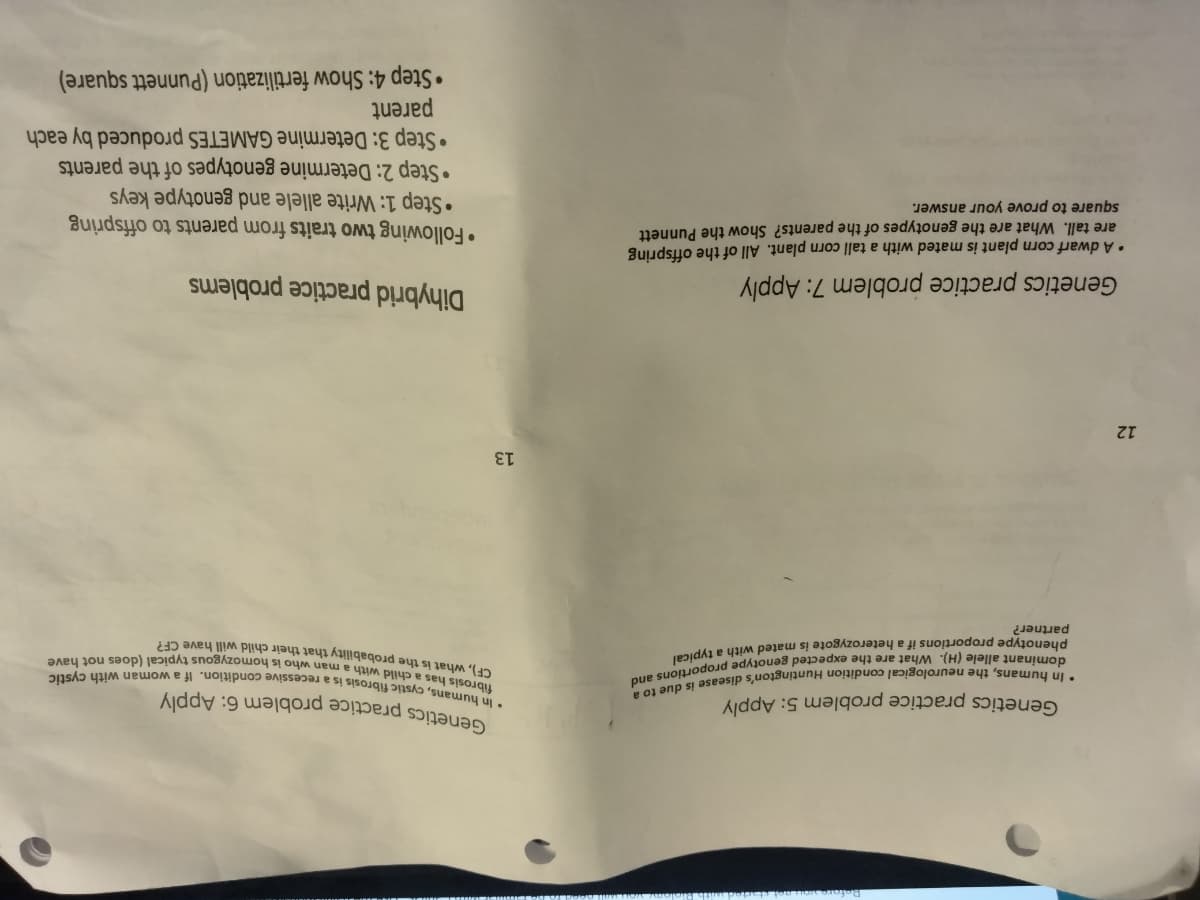12 Genetics practice problem 5: Apply In humans, the neurological condition Huntington's disease is due to a dominant allele (H). What are the expected genotype proportions and phenotype proportions if a heterozygote is mated with a typical partner? Genetics practice problem 7: Apply • A dwarf corn plant is mated with a tall corn plant. All of the offspring are tall. What are the genotypes of the parents? Show the Punnett square to prove your answer. Genetics practice problem 6: Apply In humans, cystic fibrosis is a recessive condition. If a woman with cystic fibrosis has a child with a man who is homozygous typical (does not have CF), what is the probability that their child will have CF? 13 Dihybrid practice problems Following two traits from parents to offspring Step 1: Write allele and genotype keys Step 2: Determine genotypes of the parents Step 3: Determine GAMETES produced by each parent Step 4: Show fertilization (Punnett square)
12 Genetics practice problem 5: Apply In humans, the neurological condition Huntington's disease is due to a dominant allele (H). What are the expected genotype proportions and phenotype proportions if a heterozygote is mated with a typical partner? Genetics practice problem 7: Apply • A dwarf corn plant is mated with a tall corn plant. All of the offspring are tall. What are the genotypes of the parents? Show the Punnett square to prove your answer. Genetics practice problem 6: Apply In humans, cystic fibrosis is a recessive condition. If a woman with cystic fibrosis has a child with a man who is homozygous typical (does not have CF), what is the probability that their child will have CF? 13 Dihybrid practice problems Following two traits from parents to offspring Step 1: Write allele and genotype keys Step 2: Determine genotypes of the parents Step 3: Determine GAMETES produced by each parent Step 4: Show fertilization (Punnett square)
Human Heredity: Principles and Issues (MindTap Course List)
11th Edition
ISBN:9781305251052
Author:Michael Cummings
Publisher:Michael Cummings
Chapter6: Cytogenetics: Karyotypes And Chromosome Aberrations
Section: Chapter Questions
Problem 2CS: Genetics in Practice case studies are critical-thinking exercises that allow you to apply your new...
Related questions
Question

Transcribed Image Text:12
Genetics practice problem 5: Apply
. In humans, the neurological condition Huntington's disease is due to a
dominant allele (H). What are the expected genotype proportions and
typical
partner?
Genetics practice problem 7: Apply
• A dwarf corn plant is mated with a tall corn plant. All of the offspring
are tall. What are the genotypes of the parents? Show the Punnett
square to prove your answer.
Genetics practice problem 6: Apply
In humans, cystic fibrosis is a recessive condition. If a woman with cystic
fibrosis has a child with a man who is homozygous typical (does not have
CF), what is the probability that their child will have CF?
13
Dihybrid practice problems
Following two traits from parents to offspring
Step 1: Write allele and genotype keys
Step 2: Determine genotypes of the parents
Step 3: Determine GAMETES produced by each
parent
Step 4: Show fertilization (Punnett square)
Expert Solution
This question has been solved!
Explore an expertly crafted, step-by-step solution for a thorough understanding of key concepts.
This is a popular solution!
Trending now
This is a popular solution!
Step by step
Solved in 3 steps with 1 images

Knowledge Booster
Learn more about
Need a deep-dive on the concept behind this application? Look no further. Learn more about this topic, biology and related others by exploring similar questions and additional content below.Recommended textbooks for you

Human Heredity: Principles and Issues (MindTap Co…
Biology
ISBN:
9781305251052
Author:
Michael Cummings
Publisher:
Cengage Learning

Human Heredity: Principles and Issues (MindTap Co…
Biology
ISBN:
9781305251052
Author:
Michael Cummings
Publisher:
Cengage Learning